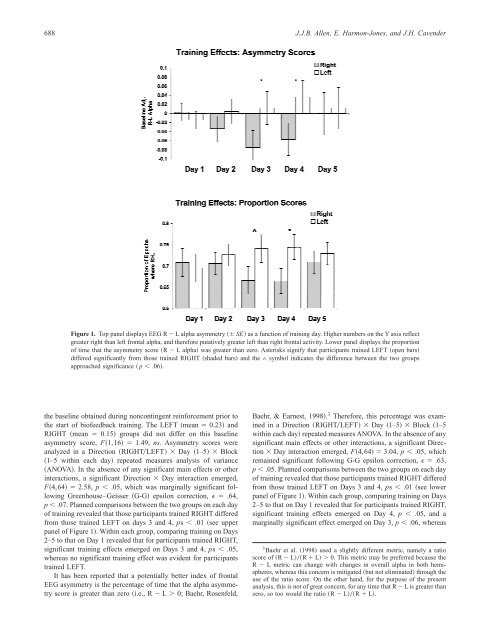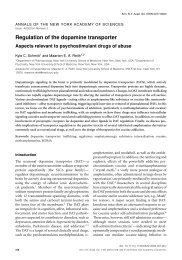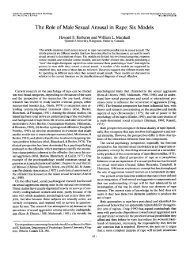Manipulation of frontal EEG asymmetry through biofeedback alters ...
Manipulation of frontal EEG asymmetry through biofeedback alters ...
Manipulation of frontal EEG asymmetry through biofeedback alters ...
You also want an ePaper? Increase the reach of your titles
YUMPU automatically turns print PDFs into web optimized ePapers that Google loves.
688 J.J.B. Allen, E. Harmon-Jones, and J.H. Cavender<br />
Figure 1. Top panel displays <strong>EEG</strong> R L alpha <strong>asymmetry</strong> ~6 SE! as a function <strong>of</strong> training day. Higher numbers on the Y axis reflect<br />
greater right than left <strong>frontal</strong> alpha, and therefore putatively greater left than right <strong>frontal</strong> activity. Lower panel displays the proportion<br />
<strong>of</strong> time that the <strong>asymmetry</strong> score ~R L alpha! was greater than zero. Asterisks signify that participants trained LEFT ~open bars!<br />
differed significantly from those trained RIGHT ~shaded bars! and the ∧ symbol indicates the difference between the two groups<br />
approached significance ~ p .06!.<br />
the baseline obtained during noncontingent reinforcement prior to<br />
the start <strong>of</strong> bi<strong>of</strong>eedback training. The LEFT ~mean 0.23! and<br />
RIGHT ~mean 0.15! groups did not differ on this baseline<br />
<strong>asymmetry</strong> score, F~1,16! 1.49, ns. Asymmetry scores were<br />
analyzed in a Direction ~RIGHT0LEFT! Day ~1–5! Block<br />
~1–5 within each day! repeated measures analysis <strong>of</strong> variance<br />
~ANOVA!. In the absence <strong>of</strong> any significant main effects or other<br />
interactions, a significant Direction Day interaction emerged,<br />
F~4,64! 2.58, p .05, which was marginally significant following<br />
Greenhouse–Geisser ~G-G! epsilon correction, E .64,<br />
p .07. Planned comparisons between the two groups on each day<br />
<strong>of</strong> training revealed that those participants trained RIGHT differed<br />
from those trained LEFT on days 3 and 4, ps .01 ~see upper<br />
panel <strong>of</strong> Figure 1!. Within each group, comparing training on Days<br />
2–5 to that on Day 1 revealed that for participants trained RIGHT,<br />
significant training effects emerged on Days 3 and 4, ps .05,<br />
whereas no significant training effect was evident for participants<br />
trained LEFT.<br />
It has been reported that a potentially better index <strong>of</strong> <strong>frontal</strong><br />
<strong>EEG</strong> <strong>asymmetry</strong> is the percentage <strong>of</strong> time that the alpha <strong>asymmetry</strong><br />
score is greater than zero ~i.e., R L 0; Baehr, Rosenfeld,<br />
Baehr, & Earnest, 1998!. 3 Therefore, this percentage was examined<br />
in a Direction ~RIGHT0LEFT! Day ~1–5! Block ~1–5<br />
within each day! repeated measures ANOVA. In the absence <strong>of</strong> any<br />
significant main effects or other interactions, a significant Direction<br />
Day interaction emerged, F~4,64! 3.04, p .05, which<br />
remained significant following G-G epsilon correction, E .63,<br />
p .05. Planned comparisons between the two groups on each day<br />
<strong>of</strong> training revealed that those participants trained RIGHT differed<br />
from those trained LEFT on Days 3 and 4, ps .01 ~see lower<br />
panel <strong>of</strong> Figure 1!. Within each group, comparing training on Days<br />
2–5 to that on Day 1 revealed that for participants trained RIGHT,<br />
significant training effects emerged on Day 4, p .05, and a<br />
marginally significant effect emerged on Day 3, p .06, whereas<br />
3 Baehr et al. ~1998! used a slightly different metric, namely a ratio<br />
score <strong>of</strong> ~R L!0~R L! 0. This metric may be preferred because the<br />
R L metric can change with changes in overall alpha in both hemispheres,<br />
whereas this concern is mitigated ~but not eliminated! <strong>through</strong> the<br />
use <strong>of</strong> the ratio score. On the other hand, for the purpose <strong>of</strong> the present<br />
analysis, this is not <strong>of</strong> great concern, for any time that R L is greater than<br />
zero, so too would the ratio ~R L!0~R L!.










